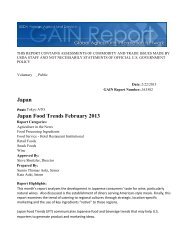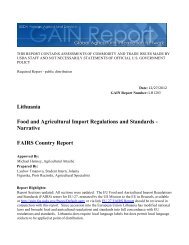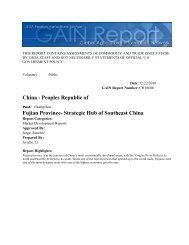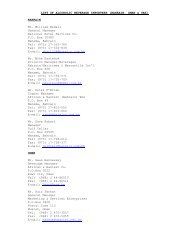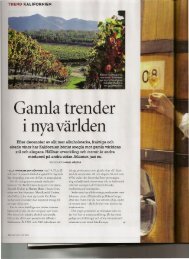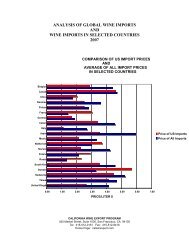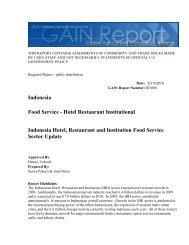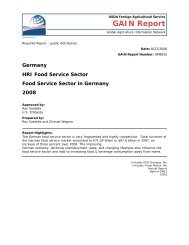Brazil Wine Market Report JBC EMP July 2011 - California Wine ...
Brazil Wine Market Report JBC EMP July 2011 - California Wine ...
Brazil Wine Market Report JBC EMP July 2011 - California Wine ...
You also want an ePaper? Increase the reach of your titles
YUMPU automatically turns print PDFs into web optimized ePapers that Google loves.
42<br />
<strong>Brazil</strong>ian <strong>Wine</strong> <strong>Market</strong> <strong>Report</strong><br />
Paragraph 1. It is forbidden the use of inert gases for the treatment of wines.<br />
Article 32. Control of malolactic fermentation is to add substance to the must in order to<br />
control the growth and activity of bacteria responsible for malolactic fermentation, as well<br />
as to reduce the rate of sulfur dioxide.<br />
Article 33. Correction or enrichment of musts is to correct the deficiency of the sugar<br />
content of the wine due to the unfavorable conditions of ripeness of the grapes for winemaking,<br />
through following:<br />
I - addition to the mash of sucrose (sugaring), alcohol, wine, grape must or rectified<br />
concentrated must concentrated, and<br />
II - partial dehydration of grape must.<br />
Paragraph 1. The fix provided in this Article shall respect the maximum limit established by<br />
legislation.<br />
Article 34. Alcoholic fermentation is to convert grape sugar into ethanol, carbon dioxide and<br />
secondary products aimed at making wine or derived from the grape or wine.<br />
§ 1 The alcoholic fermentation can occur spontaneously through natural yeast<br />
present in the film or the berries in the must or by treatment with selected yeasts,<br />
before or during fermentation, with the aim of:<br />
I - induce, regulate or accelerate the fermentation in the case of very slow<br />
vinification;<br />
II - to revive a stopped fermentation, or<br />
III - to facilitate the depletion of sugar.<br />
§ 2 can be added to the wort before or during fermentation, fermentation activators,<br />
with order to:<br />
I - to promote the initiation or completion of alcoholic fermentation and by<br />
nutrient enrichment growth factors or inhibitors by adsorption of yeast.<br />
II - accelerating the fermentation;<br />
III - decrease the formation of substances capable of combining with sulfur<br />
dioxide during the fermentation;<br />
IV - to prevent or treat the termination of fermentation, and<br />
V - to facilitate the completion of slow fermentation.<br />
§ 3 The introduction of air into the must or crushed grapes at the beginning of the<br />
fermentation can also be a practice adopted to encourage the growth of yeast and<br />
fermentation and enable transformation full of fermentable sugars.<br />
§ 4 The fermentation can be interrupted by physical process with the aim of<br />
generating a product with the remaining grape sugar. To do so will be allowed the<br />
following:<br />
I - heat treatment (heat or cold);<br />
II - filtration, and<br />
III - spin.<br />
Article 35. Procedure to limit the foam is to dominate the foaming during alcoholic<br />
fermentation of must by means of microbiological process, with physical or chemical<br />
order to:<br />
I - avoid losses by overflow, and<br />
II - to enable better capacity utilization of the fermentation tank.



